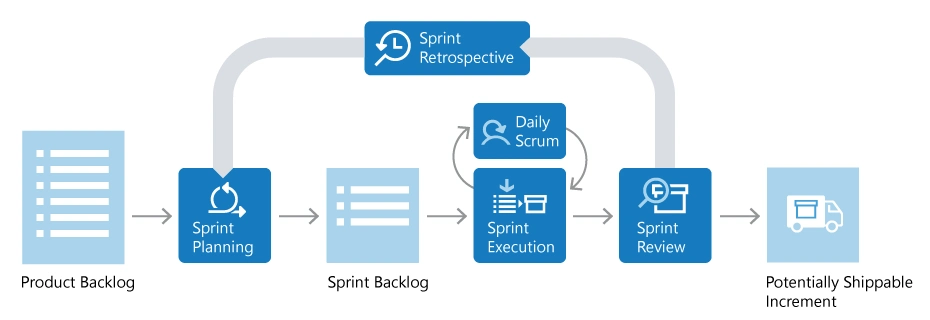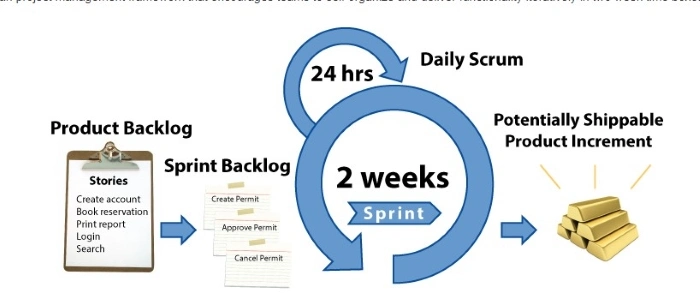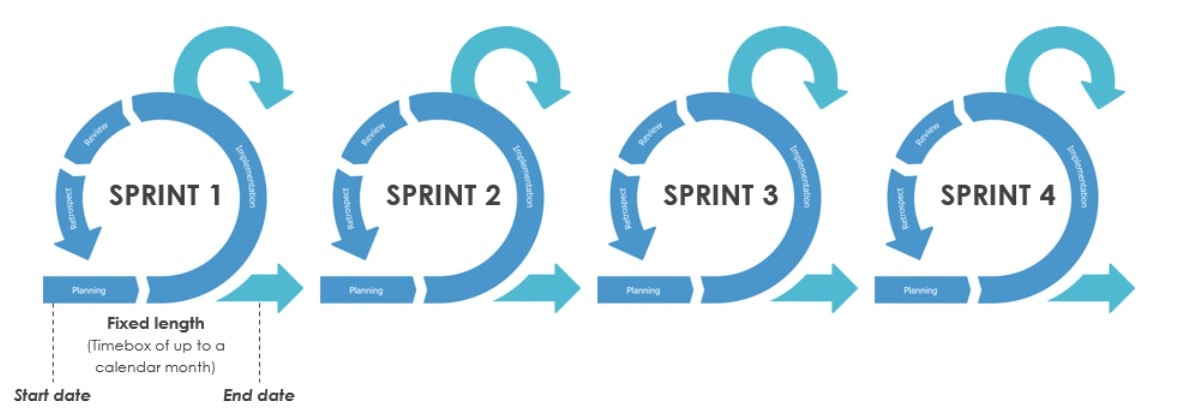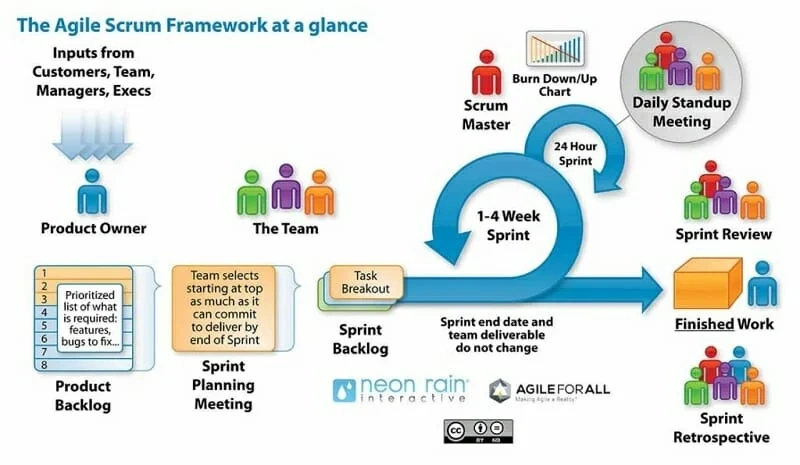A Sprint (iteration) is a period in which a development team works in the scrum methodology on specific tasks leading to achieving a precisely defined goal.
What is a Sprint? What is the average duration of a Sprint? What tasks are delegated to the scrum team?
This term should be associated with agile methodologies. Sprint is one of their crucial and fundamental elements.
In practice, Sprints last up to two weeks. The essence of Sprints is the delivery of specific working software (e.g., particular functionality).
Remember, however, that this approach isn't about developing a web or mobile application from scratch (especially in such a short time) but about finishing work with smaller scope, complexity, and importance.
It's worth noting that Agile, Scrum, and Sprint aren't synonymous and can't be used randomly.
So let's organize them.
Agile is a methodology, a set of principles, and rules of conduct. By following them, you can make your goals a reality.
Scrum is a framework, specific structure, and model using Agile principles.
Sprint is a time frame that allows the development team to order and split the project into smaller and autonomous parts.
It's a repetitive and fixed structure that aims to deliver the highest quality product.
Sprint is an essential fundament of the agile methodology and is treated as an event that includes all the others, such as Daily Scrum, Sprint Review, and Sprint Retrospective.
So much for the introduction. If we've caught your attention, we cordially invite you to read this article in which we'll discuss the characteristics of Sprint and ways of planning it.
So, you can find in this article everything you wanted to know about Sprint but were afraid to ask.
Enjoy!
What is the purpose of Sprints, or why are Sprints essential for creating a digital product?
We're sure you're familiar with updating mobile apps, web apps, and software you use on desktops and laptops.
We can safely assume that almost all digital products that are constantly being developed are products created in the formula "work-in-progress."
Does every update from the user's perspective mean a radical change?
Of course not, but changes are occurring incrementally, more or less noticeably to the end user.
In most cases, we can also safely assume that software updates result from using agile methodologies and Sprints by a development team.
Why should you create software in Sprints?
The most crucial reasons include the following:
- Lack of full and unambiguous vision of the project, digital product
- No defined scope of work, project
- Lack of precise and exhaustive software requirements specification
- Changes in business or the market
- Relatively low costs of failure — the short time of a Sprint allows you to take risks.
The best, most up-to-date, and illustrative example of the above is the design of an accounting app created during the Polish Order's implementation.

The changing legal situation (numerous amendments to the law) and the lack of a clear interpretation of existing laws translate into a high degree of project uncertainty and the need for rapid, flexible adaptation of the scope of work to new realities.
Another example can be the desire to test the idea for a functionality, checking how end users will react to it and what evaluations, reactions, problems, and emotions will be associated with offering it.
Sprints in such situations are ideal because they allow you to reduce losses if the situation changes and initial assumptions of the project will need to be adapted.
The crucial rule of Agile is "Do Fast, Fail Quick," thanks to which financial, time, organizational, and business costs are much lower.
All these matters have significant meaning for the following:
- Quality of the software
- Competitiveness of the software
- Time of project execution
- Flexibility of the project
- Motivation and engagement
- Optimization and improvement of work efficiency.
Moreover, Sprints allow you to maintain a stable pace of work. They counteract the feeling of being overwhelmed by the scale of the project and responsibility.
They also provide feedback that is crucial for complex and demanding projects.
Regular feedback that is often provided and refers to smaller elements is essential. It allows you to detect mistakes, generate ideas and solutions, and see problems that were invisible or hard to predict before conducting a Sprint.
Significant advantages of Sprint include also:
- Reduced time of debugging — debugging is usually one of the most time-consuming tasks in any project
- Evolutionary, gradual, and more optimal implementation of changes
- Offering software that is more user-friendly for end users, especially when the software is already on the market, being used by users
- Opportunity to check understanding and communication in the scrum team.
- Generally, the advantage of short time frames of Sprints means a greater focus on small incremental changes.
A smaller scale means more control over the scope, course of work, and results. It also helps obtain greater flow throughout the project.

In summary, within time-defined iterations, the scrum team works on a precisely defined goal, often on a piece of incremental code representing only a fragment of the entire project that can be tested and used.
Throughout a Sprint, each team member is simultaneously responsible for their task and keeping the team's common vision in mind.
During a Sprint, you should follow the following rules:
- Don't change or modify adopted goals
- Don't prolong the Sprint beyond the conventional two weeks.
How to plan a Sprint?
The course and effectiveness of every Sprint depend on careful planning and the established Sprint goal.
The most crucial elements include the following:
- Defining goals (short- and long-term) that should be achieved during a given Sprint, they should be related to the product, and remember that you should establish them before the Sprint begins
- Determining the duration — along with starting and ending dates
- Prioritizing and determining problems (business and technological) that should be solved during the Sprint
- Adjusting the Sprint to the business context, market, and external factors, allowing to bypass the obstacles and achieve smooth implementation (e.g., legal factors)
- Determining the size and competencies of the team (e.g., whether the team needs to consist of front-end, back-end, or full-stack developers).
Sprint Planning and the goal of the Sprint should be proportional to the Sprint's length; in the case of two-weeks iterations, they shouldn't take more than one working day.
A Sprint planning meeting can help you plan your upcoming Sprint. It's about planning the amount of work which should be neither too much nor too little. Too little work won't be beneficial regarding the budget of the project, and in turn, too much work will result in team burnout, problems with meeting deadlines, and the quality of the software.
Remember that the human factor is essential in Sprint planning — the goal of Sprint should take this into account.
Thus, in particular, the Scrum Master who is responsible for a Sprint planning session has to pay attention to the following:
- Number of members and competencies of the development team
- Involvement of team members in other projects
- Adequate prioritizing of tasks and dependencies occurring between them and their consequences
- Proper timing for starting the Sprint.
The proper configuration of team members, their current tasks, and the smooth flow of work affect the atmosphere of work, the sense of meaningfulness, purposefulness, and clarity.

All of these elements create a context that affects how Scrum team members perceive their role, function, tasks, effectiveness, and impact within the team and the project.
The better the Sprint is planned, the better the atmosphere during its course.
Planning also affects communication, cooperation, interaction, sense of responsibility, and information flow.
Since Sprint is cyclical and simultaneously focused only on a selected fragment, it's necessary to list all essential activities to finish the project in the desired form and time.
A tool that is used for Sprint planning is the Sprint Backlog which allows you to:
- Estimate the amount of work
- Prioritize activities (such as user stories)
- Plan execution of tasks over time
- Move unfinished activities to subsequent iterations (e.g., with a Sprint retrospective, you can determine what you should do in the future Sprints and what you didn't accomplish in the last Sprint).
Sprint Backlog (Product Backlog) can also be used to introduce new tasks and concepts that appeared during the creation of the digital product.
The Sprint Backlog also enables you to:
- Determine the productivity and efficiency of the team
- Optimize tasks
- Determine the pace of the increment
- Look for time savings
- Manage projects (e.g., through courses and appropriate application of methodology).
A handy tool for Sprint planning that is used by most teams during Sprints is a checklist that should account for the following:
- Debt regarding technology and quality
- Alignment of perspectives of all team members (the direction of activities should be clear to all and defined in the same way)
- Attention to unknown tasks or risky ones
- Attention to individual members of the team, especially in terms of feedback and workload
- Appropriate ordering of the backlog and priority work
- Consideration of changes in the progress of work resulting from leaves, holidays, non-working days, team meetings
- Providing all team members with access to the Backlog.
Roles in Sprint and its structure
A Scrum team consists of three crucial roles:
- Scrum Master
- Product Owner
- Scrum Team.
Scrum Master is essential for Sprint because:
- They're a facilitator for the development team (they manage the ways of interaction and run meetings, Daily Stand-up)
- They support team members during the Sprint (in terms of technology and interpersonal relationships and organizational barriers)
- They're responsible for facilitating cooperation between all roles and functions
- They're also responsible for solving problems of resources.
Scrum Team usually consists of developers, designers, and testers who have the following tasks:
- Development of the digital product
- Testing the product.
The task of Product Owners is to:
- Represent users of the product
- Create a bridge between the development team and stakeholders
- Create and communicate the product vision
- Ensure that all requirements are met, such as those regarding business, functions, and market
- Acceptance or rejection of accomplished work within a given Sprint.
Scrum should also be associated with repetitive rituals and ceremonies that are essential to the Sprint.
Daily Stand-ups/Daily Scrum are daily meetings (usually they don't last longer than 15 minutes) of team members that serve to:
- Better synchronize the work, time, and tasks
- Control the progress, check whether the course of work is in line with the adopted schedule
- Discuss the progress, problems, obstacles, and successes
- Get the team members up to speed.
Another fixed element is Sprint Review, which occurs after a given iteration ends.
Its main goal is to present to stakeholders the results of the Sprint (finished, tested pieces of code), mainly what was achieved and what is yet to be completed.

Sprint Retrospective occurs after Sprint Review and before the next Sprint.
Its primary purpose is to discuss achievements, challenges, next goals, and obstacles — to establish a common course of action and to check how far requirements (e.g., of customers) have been met.
Streamlining the process not only serves to improve processes but also to allow better planning for the next Sprint (Sprint Planning).
By the way, we recommend an excellent article by Anna Kaley, associated with the Nielsen Norman Group, who touched on the relationship between Scrum Ceremonies and User Experience.
Be sure to take a look at her article "UX Responsibilities in Scrum Ceremonies." The relationship between development teams and UX specialists is rarely described in the context of agile methodologies hence reading this article is additionally valuable.
What is a Sprint? Summary
- Sprint (also Sprint Design), an iteration, is a defined period (usually lasting no more than two weeks) during which a team of programmers, developers, and designers work on specific tasks to create working software.
- For example, a specific functionality can be created during a Sprint.
- Sprint, Agile, and Scrum are not synonymous.
- Agile is a methodology, Scrum is a framework, and Sprint is a time frame that allows you to split the project into smaller, independent parts.
- The increment of complex software in terms of technology, organization, testing, optimization, and research has its own specific requirements. For example, regarding the long time, which brings many risks (e.g., work becomes less efficient), which Sprints allow you to avoid.
- Above all, in large projects, the progress of work is harder to see, sometimes affecting the motivation of development, design, research, and testing teams. And this significantly impacts the quality of completed tasks and their effects.
- Sprint also allows you to reduce the risk regarding budget, time, organization, and business.
- Sprints also counteract the feeling of being overwhelmed and overly responsible and provide feedback, which is very important in large, complex projects.
- The main advantage of Sprints is the reduced debugging time and an evolutionary, more optimal introduction of software changes.
- Thanks to Sprints, there is also better communication within the development team and more control over the scope, workflow, and results.
- Sprints are also used to achieve greater flow during the project — the flow depends on effective Sprint planning, the definition of responsibilities, and authority.
- Proper Sprint planning positively impacts the work atmosphere, communication, and, ultimately, how perfect the digital product is.
- Appropriate Sprint planning also determines the way of cooperation, workflow, interactions, sense of responsibility, information flow, and, ultimately, the quality of the software.
- Scrum Teams consist of three crucial roles: Scrum Master, Product Owner, and Scrum Team.






